Accepted Scientific Name: Pritchardia remota (Kuntze) Becc.
Malesia 3: 294 (1890)
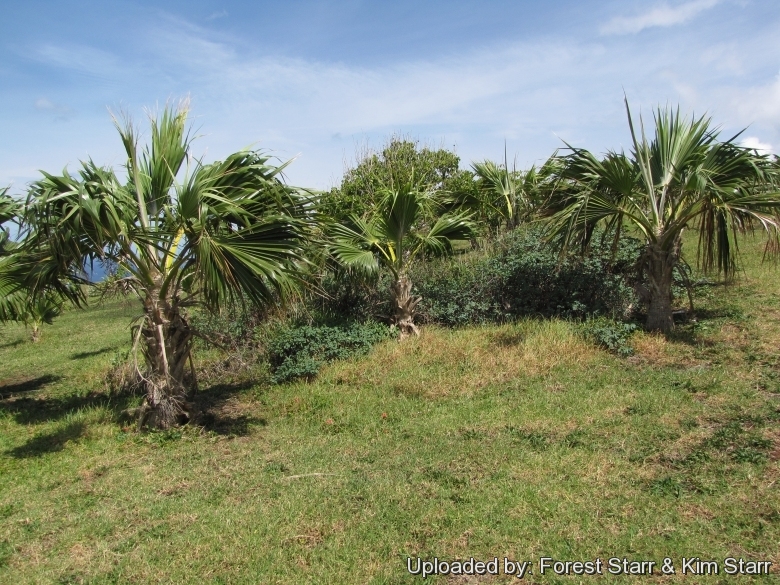
Washingtonia remota (Pritchardia remota) Photo by: Forest Starr & Kim Starr
Outplantings at Crater Hill Kilauea Pt NWR, Kauai, Hawaii (USA). March 21, 2013.
Origin and Habitat: Pritchardia remotaSN|24647]]SN|24647]] has a very narrow geographic distribution in the northwest Hawaiian island of Nihoa ( a small ancient island northwest of Kaua'i also known as the "Bird Island"), and later transplanted to the island of Laysan (USA).
Altitude: 200-800 m elevation.
Habitat: It grow in xeric scrub and open forests communities in coastal valley depressions (conversely all the other Hawaiian species are found in mesic or wet vegetation) at the base of cliffs and on high cliff terraces. It was once very abundant in its known range, but now only about 680 of these trees remain in two populations, making the species endangered but numbers are slowly increasing. The area is apparently free from feral animal.
Synonyms:
See all synonyms of Pritchardia remota
back
Accepted name in llifle Database:Pritchardia remota (Kuntze) Becc.Malesia 3: 294 (1890)Synonymy: 5
back
Common Names include:
ENGLISH: Nihoa Fan Palm, Pritchardia's fan palm, Nihoa pritchardia, Nihoa Palm
CHINESE (中文): Bo li cha de zong
HAWAIIAN (ʻŌlelo Hawaiʻi): Lo‘ulu, Hawane, Loulu, Noulu, Wahane
Description: Pritchardia remotaSN|24647]]SN|24647]] is one of the smallest in the genus, usually not more than 4–5 m tall (though taller individuals has been reported in cultivation in Hawaii). It distinguish from other Pritchardia species by its wavy leaves, its short and hairless inflorescences, and its tiny, spherical fruits. This species may be confused with Pritchardia hillebrandiiSN|24628]]SN|24628]] but the crown of Pritchardia remotaSN|24647]]SN|24647]] is more untidy and the leaves are much more deeply divided.
Trunk: Solitary, up to 15 centimetres in diameter, slim, flexuous, ringed by leaf scars that are left after leaves have fallen.
Crown: Dense and untidy looking due to the deeply divided leaves with drooping tips.
Leaves: Leaf blades about 85 cm long, costapalmate, moderately plicate (folded like a fan from the base to the tips of the leaf), somewhat ruffled with drooping tips, split about 1/3 their length and nearly semicircular, smooth on the top surface, but slightly waxy and very lightly covered with tiny scales on the lower side. Petiole up to 1 m long.
Inflorescence: Large, many branched, shorter than the petiole visible beneath the leaf crown. The flowers are arranged spirally along the branches.
Fruit: Near spherical to ovoid, approximately 20 x 18 mm dark brown or black at maturity with only one seed. The fruit has tree layers: a shining outer skin (exocarp), a fibrous middle layer (mesocarp), and a hard inner endocarp.
Seed: 13-15 mm in diameter. The seed is attached to the endocarp at one small spot called the hilum.
Notes: Pritchardia remota complex is a group of similar species closely related owing to their recent and usually still incomplete reproductive isolation. The additional palms in the complex are: Pritchardia aylmer-robinsonii, Pritchardia glabrataSN|24625]]SN|24625]], Pritchardia napaliensis and Pritchardia wailealeana.
Bibliography: Major references and further lectures
1) Forest & Kim Starr Pritchardia remota (Nihoa fan palm). Plants of Hawaii. <http://www.starrenvironmental.com>. Downloaded on 21 August 2014.
2) Gemmill, C. 1998. Pritchardia remota. The IUCN Red List of Threatened Species. Version 2014.2. <www.iucnredlist.org>. Downloaded on 06 September 2014.
3) David Leaser "Growing Palm Trees in Hawaiʻi and Other Tropical Climates", page 78.
4) Heidi Leianuenue Bornhorst “Growing Native Hawaiian Plants: A How-to Guide for the Gardener” Bess Press, 01/Apr/2005
5) Palmpedia contributors. "Pritchardia remota." Palmpedia, PALM ENCYCLOPEDIA, <http://www.palmpedia.net> Downloaded on 26 Aug. 2014
6) Wikipedia contributors. "Pritchardia remota." Wikipedia, The Free Encyclopedia. Wikipedia, The Free Encyclopedia, 21 Jan. 2014. Web. 5 Sep. 2014.
7) Chapin, M.H., K.R. Wood, S.P. Perlman, and M. Maunder. 2004. "A review of the conservation status of the endemic Pritchardia palms of Hawai‘i." Oryx 38(3): 273-281.
8) Hodel, D.R. 2007. "A Review of the Genus Pritchardia." Palms 51(supplement): S1-S52.
9) "Pritchardia remota ." National Tropical Botanical Garden <http://ntbg.org/plants/plant_details.php?plantid=9497>
10) Dieter Mueller-Dombois and F. Raymond Fosberg "Vegetation of the Tropical Pacific Islands"
11) Neal L. Evenhuis "Natural History of Nihoa and Necker Islands" by, 46, 62-63
12) Donald R. Hodel "Loulu--The Hawaiian Pritchardia" by, The Palm Journal 193, pages 10, 12.
13) Rerioterai Tava "Niihau--The Traditions of an Hawaiian Island" by, pages 32, 34, 63.
14) David Gledhill "The Names of Plants" by, page 328
15) "Pritchardia remota." PACSOA Palms and Cycads wiki , <http://www.pacsoa.org.au> Accessed on 28 Aug. 2014
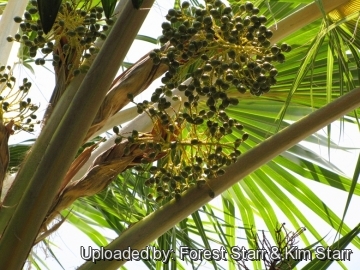 Fruit at Iao Tropical Gardens of Maui, Maui, Hawaii (USA). May 22, 2012. (Pritchardia remota) Photo by: Forest Starr & Kim Starr
Fruit at Iao Tropical Gardens of Maui, Maui, Hawaii (USA). May 22, 2012. (Pritchardia remota) Photo by: Forest Starr & Kim Starr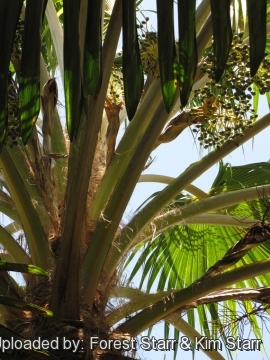 Crown and fruit at Iao Tropical Gardens of Maui, Maui, Hawaii (USA). May 22, 2012. (Pritchardia remota) Photo by: Forest Starr & Kim Starr
Crown and fruit at Iao Tropical Gardens of Maui, Maui, Hawaii (USA). May 22, 2012. (Pritchardia remota) Photo by: Forest Starr & Kim Starr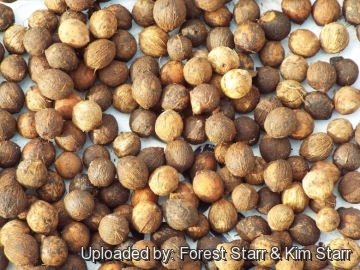 Washingtonia remota (Pritchardia remota) Photo by: Forest Starr & Kim Starr
Washingtonia remota (Pritchardia remota) Photo by: Forest Starr & Kim Starr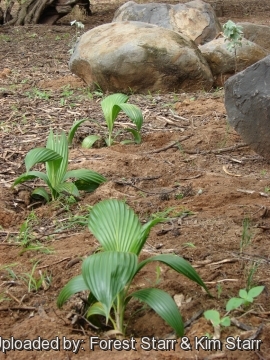 Planting at Kanaha Beach, Maui, Hawaii (USA). January 09, 2008. (Pritchardia remota) Photo by: Forest Starr & Kim Starr
Planting at Kanaha Beach, Maui, Hawaii (USA). January 09, 2008. (Pritchardia remota) Photo by: Forest Starr & Kim Starr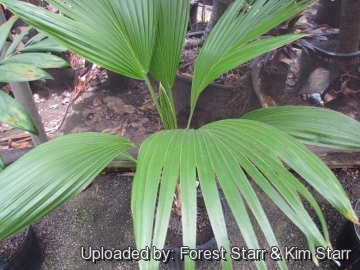 In pot at Iao Tropical Gardens of Maui, Maui, Hawaii (USA). May 22, 2012. (Pritchardia remota) Photo by: Forest Starr & Kim Starr
In pot at Iao Tropical Gardens of Maui, Maui, Hawaii (USA). May 22, 2012. (Pritchardia remota) Photo by: Forest Starr & Kim Starr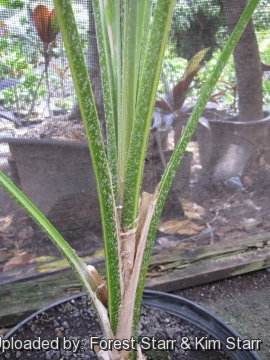 Base at Iao Tropical Gardens of Maui, Maui, Hawaii (USA). May 22, 2012. (Pritchardia remota) Photo by: Forest Starr & Kim Starr
Base at Iao Tropical Gardens of Maui, Maui, Hawaii (USA). May 22, 2012. (Pritchardia remota) Photo by: Forest Starr & Kim StarrCultivation and Propagation: According to its habitat Pritchardia remotaSN|24647]]SN|24647]] may be drought tolerant, cool tolerant and modest in its requirement. Since it is the north most naturally occurring Pritchardia, it seems to be better adapted to Mediterranean-type climates than any other species in the genus.
Soil: Sand, cinder organic soil, but is adaptable. Good drainage is also important.
Fertilization: Need a perfect fertilizer diet including all micro nutrients and trace elements or slow release fertilizer. Fertilize often for faster growth.
Water Requirements: It tolerates low levels of humidity, though it prefers evenly moist but not consistently wet medium. When supplied with adequate moisture and fertilizer it is also fairly fast growing. This palm is very drought tolerant once established. It dislikes soggy soils. The roots and lower trunk can rot if soil is kept too moist. Water young plants for healthy look and fastest growth.
Light: Prefers full sun but will tolerate half day sun.
Hardiness: It is adapted to tropical and subtropical climates but tolerate a wide range of climates and will even tolerate cool conditions; In favourable temperate climate they should be grown in cold green houses or at least in a place where they are sheltered by the wind; However mature specimens can endure light frost (for short periods), while young plants are more cold sensitive. Best kept above 5° C. (USDA zones 10-11 but quite hardy in zone 9b).
Maintenance: The dead leaves, flowers and fruits can be removed in a landscape setting for a cleaner appearance. Do not prune the fronds that still have some green colour. Palms recycle nutrients from dead or dying fronds and use them for healthier fronds. Palms only have a set number of new leaves that can sprout and grow per year and removing fronds will not increase that number. If you cut off more than what will grow annually, you could be left with a pretty bare and bald palm. Left in place they form an attractive ‘skirt’ around the trunk.
Wind and salt tolerance: Salt tolerance moderate. With a particularly windy climate it is suggested to secure young palm to long solid stakes, to avoid that the wind could bare young and not very developed roots; specimens which are only a few years old might fear intense wind.
Early Hawaiian Use The hard wood of the trunk were fashioned into spears. The trunks loulu were notched for climbing to gather the immature fruits and fronds. Older specimens still bear notches that can be seen today. The fronds were used for thatching and as plaiting such as hats and fans.
Ornamental: Even if very rare this species must be cultivated as an ornamental tree, and planted in gardens and parks in tropical and sub-tropical climates either as a single specimen in small groves of three or more palms. Culture in containers is possible although growth rates are slower. A bright patio will provide an excellent environment for young specimens which can eventually be planted in a sunny location.
Propagation: Sow fresh seeds buried half way in pot of clean, well drained potting soil, water daily and keep them at high temperatures (25 to 35 °C). Germination starts five week after sowing and can be spread over 21 weeks the seeds have a high germination rate and seedlings grow well in the right nutrient, temperature, and light conditions. Seeds do not require light for germination. Complete germination (98 to100%) is promoted by removal of the outer husk from the seeds. This is most easily achieved by soaking the seeds for at least 24 hours. After removal of the outer husk the seeds can be germinated. Seedling plants of 30 cm can be put in ground/larger pot; Because these palms easily hybridize with other Pritchardias, claiming a specific species requires seed collection from wild populations. Seeds remain viable for 2 or more years.















